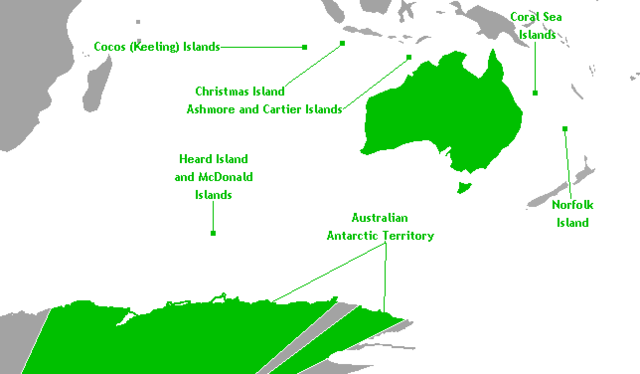States and territories of Australia

States
| Areas | Abbreviation | Capital |
| NSW | Sydney | |
| QLD | Brisbane | |
| SA | Adelaide | |
| TAS | Hobart | |
| VIC | Melbourne | |
| WA | Perth |
Territories
Mainland
| Territory | Abbreviation | Capital |
| ACT | Canberra | |
| JBT | ||
| NT | Darwin |
From 1926 to 1931, Central Australia existed as a separate territory between the 20th and 26th parallels of latitude, before being becoming a part of the Northern Territory again.
Overseas territories

Former
- Territory of North Australia (1927-31)
- Territory of Central Australia (1927-31)
- Territory of Papua (1902-49)
- Territory of New Guinea (1920-49)
- Territory of Papua and New Guinea (1949-72)
Background and overview
The states started as separate British colonies before Federation (in 1901). Their powers are protected by the Australian constitution. The territories are under the control of the Commonwealth government. The Australian Parliament has powers to create laws in the territories that it does not have in the states.
Most of the territories are directly administered by the Commonwealth government. Three of the territories (the Northern Territory, the Australian Capital Territory and Norfolk Island) administer themselves. In the territories that govern themselves, the Australian Parliament has the power to govern, and can override laws made by the territorial governments. It has done this at times, but it is rare that it happens. The Northern Territory and the Australian Capital Territory are usually treated as states.
Each state has a governor. This governor is chosen by the Queen, but she chooses the person on the advice of the state Premier. The Administrators of the Northern Territory and of Norfolk Island are chosen by the Governor-General. The Australian Capital Territory is governed by the Governor-General.
The head of government of each state is called the Premier. This person is chosen by the state's Governor. Normally the Governor will select as Premier whoever leads the lower house of the state Parliament. However, the Governor can chose someone else as Premier. The head of government of the self-governing mainland territories is called the Chief Minister. The Chief Minister of the Northern Territory, who normally whoever controls the Legislative Assembly, is appointed by the Administrator.
Statistics
| State/territory | Land area (km²) | Rank | Population (2004) | Rank | Population density (/km²) | Rank | % of population in capital | Rank |
| Australian Capital Territory | 2358 | 8th | 324300 | 7th | 137.53 | 1st | 100% | 1st |
| New South Wales | 800642 | 5th | 6760000 | 1st | 8.44 | 3rd | 63% | 5th |
| Victoria | 227416 | 6th | 5002300 | 2nd | 22 | 2nd | 71% | 4th |
| Queensland | 1730648 | 2nd | 3919500 | 3rd | 2.26 | 5th | 46% | 7th |
| South Australia | 983482 | 4th | 1537900 | 5th | 1.56 | 6th | 73.5% | 2nd |
| Western Australia | 2529875 | 1st | 1998400 | 4th | 0.79 | 7th | 73.4% | 3rd |
| Tasmania | 68401 | 7th | 484000 | 6th | 7.08 | 4th | 41% | 8th |
| Northern Territory | 1349129 | 3rd | 200800 | 8th | 0.15 | 8th | 54% | 6th |
Other websites
- Maps of Australia Archived 2008-12-04 at the Wayback Machine
- CityMayors article
Wikiwand in your browser!
Seamless Wikipedia browsing. On steroids.
Every time you click a link to Wikipedia, Wiktionary or Wikiquote in your browser's search results, it will show the modern Wikiwand interface.
Wikiwand extension is a five stars, simple, with minimum permission required to keep your browsing private, safe and transparent.